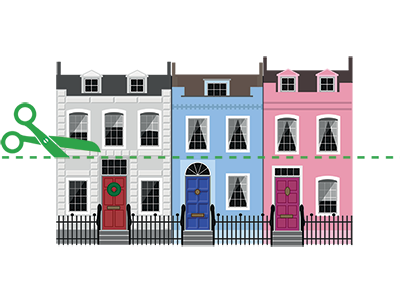What is a Period Converted Flat?
What is a converted flat?
A converted flat is a single-storey residential dwelling created from a larger house or building, such as a commercial office block.
What is a period conversion?
Period conversion means the flats have been formed by converting a house from a particular named architectural period, such as Georgian or Victorian, so there are separate dwellings with their own front doors, often leading off a shared staircase.
What is the difference between purpose-built flats and converted flats?
Conversion flats differ from purpose-built flats in that the buildings were initially built for another purpose (house, office, hotel) and not intended as flats in the first place. Even though purpose-built flats are often synonymous with modern properties, it’s worth noting that they were also built in the Georgian, Victorian and Edwardian periods.
Converting a building into flats involves specific physical and legal challenges which can present problems with the resulting dwellings. Make sure you choose a conveyancing solicitor and a surveyor who are both skilled and experienced with period conversion flats.
What are the problems with converted flats?
Converted flats are often compared unfavourably to purpose-built flats. Buildings planned as flats from the outset can be designed with more uniformity, regularity of spaces, and generally more overall thought in the design.
Period conversion flats can have all the typical issues you may expect from any building of the same period, including damp, damaged or leaking roofs, doors or windows, dry rot, woodworm, etc.
Because developers are constrained by the layouts of the original period properties they are converting from, there may be problems with fit and materials they have to use. If the property is in a conservation area, you may not be able to upgrade certain aspects of the property and will have to replace like-for-like. Some converted flats can feel a bit of a 'square peg, round hole', where rooms and spaces have been worked around and within the original construction.
In particular, where joins are made, for example, from a new stud wall to an existing load-bearing wall, different materials used in the join may lead to condensation and dampness.
Finally, conversion flats are, in the vast majority of cases, going to be more than 70 years old, so you can expect materials, such as roof tiles and electrical wiring, to degrade if they haven’t been refurbished.
What are the benefits of period conversion flats?
That said, individual period conversion flats may be very well built, insulated and thought out: it just depends on the quality of the work of whoever converted them, how recently they converted them (building regulations were not up to current standards in the past) and how well the building has been managed and maintained since. They generally have more character and individuality than purpose-built flats and can have better rooms and overall sizes, especially if they were converted from an exceptionally spacious period property; Georgian buildings are famously elegant, with high ceilings and grand proportions.
Some less well-designed, purpose-built flats have defects affecting every flat in a block, such as dangerous cladding, which you would be less likely to find with conversions.
As with any older property, we recommend a Level 3 survey from one of our RICS surveyors to conduct a thorough inspection for any visual evidence of defects that need to be addressed before you buy the property and become liable for fixing all of its problems.
In our recent survey, 16% of homeowners found defects; including 2% who were able to pull out of a bad purchase, 7% who were able to negotiate a better price, and sadly, 7% of homeowners who did not get a survey and discovered defects after the purchase.
12 of the 39 who remembered how much these defects cost to remedy spent over £5,000
Don't burn your money, book a survey.

What type of home buyers survey should you get for buying a period conversion flat?
Generally, you should always opt for a Level 3 Survey for any period property because of its age; we would even recommend a Level 3 survey on a modern conversion flat due to the amount of alteration done on it. Your surveyor will examine the property more thoroughly in a Level 3 survey than in a Level 2 survey.
Your RICS surveyor is trained in spotting property defects; they can often detect suspicions that a recent conversion may not have been carried out soundly or in accordance with planning permission rules and building regulations. If you are considering buying any old or converted property, instructing a chartered surveyor to inspect it is a must: what looks sound may be anything but.
Do you need permission to turn a house into flats?
Former Chancellor Jeremy Hunt included plans to scrap planning permission for property owners who want to convert a house into two flats. Currently, planning permission is still required.
The 'permitted development right' will apply as long as the outside of the building remains unchanged. It aims to aid the housing shortage, creating more converted flats for home buyers and renters. There are, however, concerns regarding the inevitable parking issues. It may also harm communities, changing the character of neighbourhoods without allowing residents any opportunity to object.
Property owners will still need Building Control sign-off on the work to ensure it meets regulations. This must be obtained before work starts and inspected by a building control officer at several intervals before sign-off on completion.
Are you worried that the converted flat you're buying is missing permission?
Your conveyancing solicitor is responsible for obtaining any necessary permissions and certificates, so choose one who is experienced with period conversions. You should also instruct a regulated surveyor to conduct a Level 3 inspection of the property, checking visible signs that the conversion flat is up to code.
How much does it cost to convert a house into flats?
This will cost upwards of £15,000 - £25,000 and depends entirely on the current state of the building, how much work is required to remodel into flats and the quality of the materials and contractors you choose. Speak to several contractors about the various options for splitting the property according to building regulations and get their estimated costs.
Andrew started his career in 2000 working within conveyancing solicitor firms and grew hands-on knowledge of a wide variety of conveyancing challenges and solutions. After helping in excess of 50,000 clients in his career, he uses all this experience within his article writing for SAM, mainstream media and his self published book How to Buy a House Without Killing Anyone.
Caragh is an excellent writer and copy editor of books, news articles and editorials. She has written extensively for SAM for a variety of conveyancing, survey, property law and mortgage-related articles.









